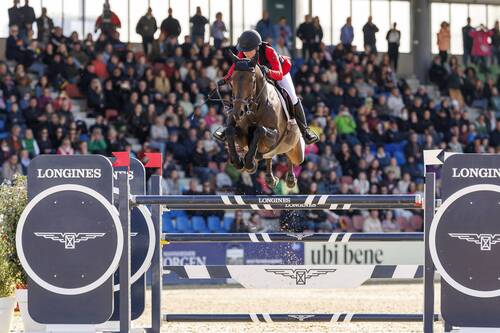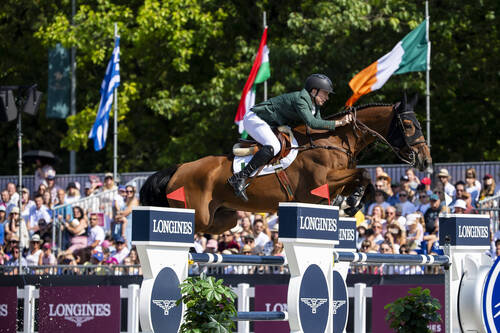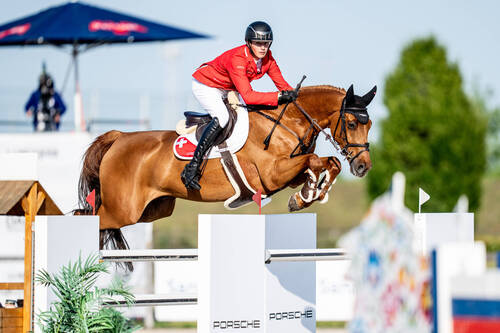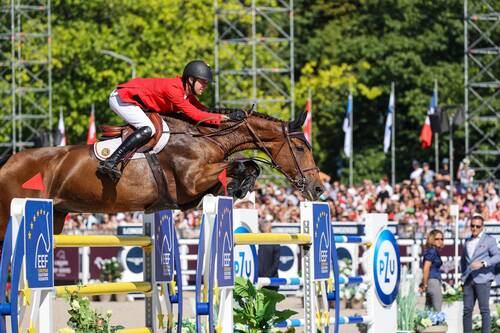Five Years On: How the Longines EEF Series Is Shaping the Future of European Show Jumping
25. Jul 2025 / Category: Press Release
Report: Emily Bevan
The brainchild of the European Equestrian Federation, the Longines EEF Series has gone from strength to strength since its inception in 2021. As the competition approaches its fifth final, we look back over its history and explore whether the event is achieving what it set out to do, which is much more than just providing a stage for healthy competition.
The Longines EEF Series was created as a stepping stone between national shows and international events, offering a pathway for nations to grow and gain experience while providing vital international exposure for horses and riders at CSIO3* level.
At the FEI European Jumping Championship in La Coruna last weekend, three of the riders who finished in the top ten of the individual final had competed in the Longines EEF Series this year.
Sophie Hinners, a member of the winning German team in Mannheim, Seamus Kennedy, who helped the Irish team to a third-place finish in Lier, and Gilles Thomas, who competed in the Belgian team which finished sixth on home turf in Lier, before going on to win team gold and individual bronze at the Europeans, all honed their skills at CSIO3* level through the Series before stepping up to Championship level.
Seamus even rode the same horse - the 10-year-old Irish Sports Horse ESI Rocky - in both events, proving how the Longines EEF Series provides valuable team competition experience not just for riders but for the horses too.
“As we celebrate the fifth anniversary of the Longines EEF Series, we reflect with great pride on how far this competition has come,” said EEF President Quentin Simonet.
“What began as a bold vision to support and develop equestrian sport across Europe has grown into a cornerstone of our calendar, nurturing rising talent, strengthening national teams, and promoting the development of promising horse-and-rider combinations. This progress has been made possible thanks to the dedication of the national federations, whose vital role in developing riders and horses across all levels continues to drive the Series forward.”
Adam Grzegorzewski is another prime example of how the Series develops, cultivates and nurtures up and coming talent and provides them with a platform in which to prove themselves.
The 27-year-old rider was a staunch member of the Polish team in the 2023 Series, contesting both the qualifiers, the semifinals and the final aboard the now 12-year-old KWPN gelding, Issem. The pair’s consistent performances across the season were instrumental in helping them to be selected for the Paris Olympics.
“It [the Longines EEF Series] really helped me to build the horses up to a bigger level and gain experience for the bigger shows,” said Adam.
Young Swiss rider Gaetan Joliat is another advocate of the event and credits the Series with filling the gap that exists between Young Rider and top-level competition.
“I was lucky enough to participate in two legs this year including Gorla Minore and Samorin. It’s a circuit I really like and that allows you to move from the young riders’ circuit to the top level,” said Gaetan.
“I had the opportunity to ride in the team with Martin Fuchs in Samorin. He was there for us, helping us and boosting our confidence and he was there with a young horse that needed to gain experience in the Nations Cup circuit. This is very interesting from a rider’s perspective and even more so when you’re a young rider. It’s amazing to ride alongside good riders in this type of competition.”
Over the previous four years of the competition, only two nations have been crowned champions. Italy have proved the dominant force, winning three of the four editions. Only Austria have managed to disrupt their reign, triumphing in 2023.
Twenty-eight nations contested the first year of the Series which took place in 2021 and included five qualifiers, one semifinal and a final. The title showdown took place at Warsaw’s Sluzewiec Racecourse and was won by Italy after they pipped Czech Republic in a nail-biting jump-off. Austria rounded off the podium in third.
Italy had an easier run to the title in 2022. Their quartet won the competition outright after they were the only team to complete on a score of four, four penalties ahead of Ireland. Austria occupied third for the second straight year.
Austria etched their name onto the winner’s trophy in 2023 after they produced a perfect performance to win the title. The team were in imperious form, producing three double clear rounds to finish ahead of Belgium while Ukraine took an emotional third place.
The trophy returned to Italy in 2024 after they came out on top in a jump-off against a young Irish team. Germany found themselves on the podium for the first time in the final when they clinched third.
Both Italy and Austria will be at this year’s final which will take place for the first time at the National Equestrian Institute of Avenches (IENA) in Switzerland, the host of the FEI Eventing European Championships in 2021.
IENA will hold the final at their 142-hectare facility through 2027, ensuring the finale takes place right in the heart of Europe at a venue which is renowned for its exceptional standards and strong history of hosting international championships and competitions.
The two teams will attempt to regain their titles after they came through the Central South semifinal in Budapest alongside Germany, Netherlands and Switzerland last month. Once again, Italy looks to be a formidable force and is the only nation to have won two legs of the Series this year after they triumphed at the qualifier in Thessaloniki and in their semifinal.
Joining them at the final will be Belgium, Spain, France, Norway and Sweden who qualified at the North West semifinal in Deauville.
The competition continues to follow the regional structure it started with, although it has grown slightly and continues to welcome new nations. This year Israel took part for the first time.
Each of the four regions – South, Central, North and West – now host two regional qualifiers between April and June. The teams contesting those qualifiers receive points based on their results and after both qualifiers have taken place those teams in the top five in each region advance to one of two semifinals. Five nations from each semifinal qualify for the final which will take place on Sunday 7 September.
Will this year see a new country add their name to the roll of honour? Regardless, it is plain to see that the competition continues to attract young talent, develop partnerships and provide combinations with the exposure and experience required to push on and enjoy success at the higher echelons of the sport. The competition continues to develop its objectives.
“Over these five years, we've witnessed an extraordinary evolution with nations stepping onto the international stage, young riders gaining invaluable experience, and horses progressing into top-level sport through this structured, competitive platform. The Series has not only deepened the sporting depth across our continent but also reinforced the spirit of unity and excellence that defines European equestrianism,” continued Quentin Simonet.
“With the continued support of Longines and the dedication of our national federations and organising committees, we look forward to building on this success and driving the sport forward in the years to come.”
For the latest news updates on the Longines EEF Series, including team announcements, results and behind-the-scenes content, follow the Longines EEF Series website and the European Equestrian Federation. Join the conversation on the Longines EEF Series social media on Instagram and Facebook.






